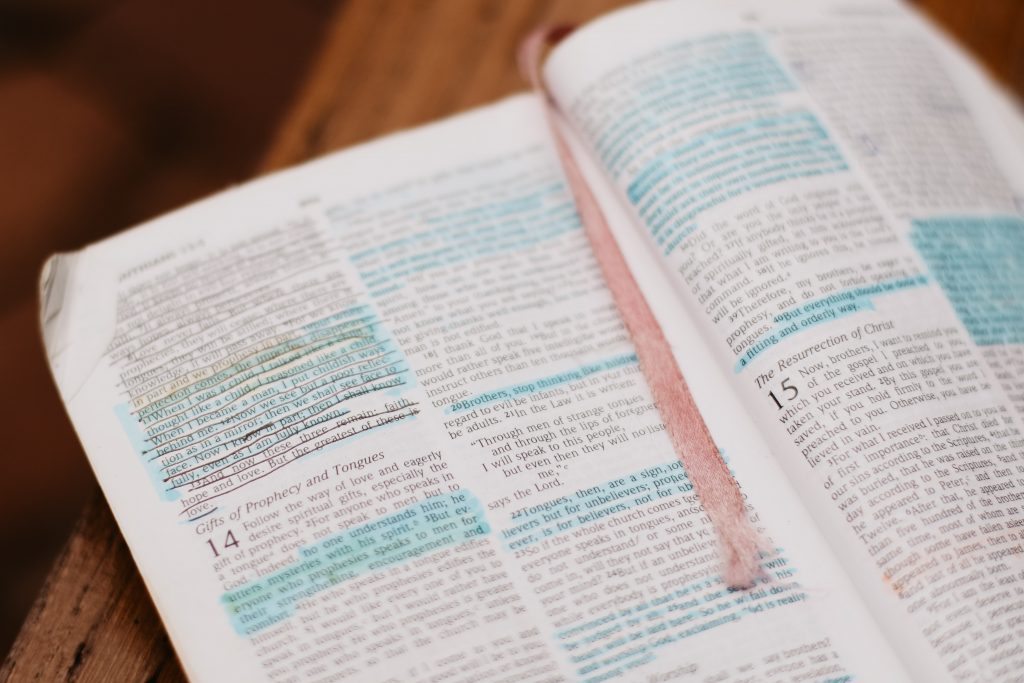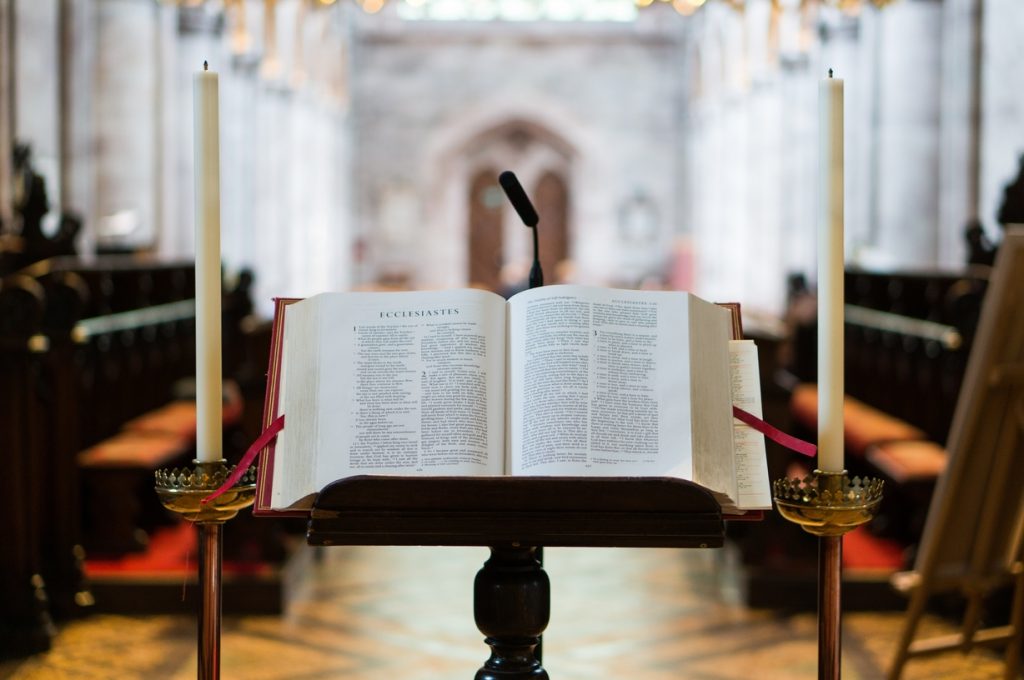What is the relationship between Sacred Scripture and Sacred Tradition? Is Sacred Scripture, or the Bible, enough on its own, or is more needed?
In this post I want to respond to these two questions and also share how you can distinguish between Sacred Apostolic Tradition and what are called “ecclesial traditions”.
What’s the difference between Sacred Scripture and Sacred Tradition?
Let’s begin our consideration of the relationship between Sacred Scripture and Sacred Tradition by first being clear about what each is.
First, Sacred Scripture—what is it exactly?
Sacred Scripture, which is often referred to as the Bible, is a collection of books, composed by human authors under the inspiration of the Holy Spirit, which contain the written truth of God’s Revelation.
RELATED: How to Interpret the Bible as a Catholic
In the words of the Second Vatican Council’s document Dei Verbum: “Sacred Scripture is the speech of God as it is put down in writing under the breath of the Holy Spirit” (Dei Verbum 9) .

Another way of putting this is that it’s the Word of God in human words. Therefore, we can understand Sacred Scripture to be the written transmission of God’s Revelation in Christ. However, as you may know, not everything, especially of God, can be contained in merely human words.
This is why we also have Sacred Tradition.
But, what is Sacred Tradition?
Well, it’s a term that refers to, and is often interchangeable with, what is called Apostolic Tradition.
This Apostolic (or Sacred) Tradition includes everything that the Twelve Apostles received from Jesus’ teaching and example, as well as what they learned from the Holy Spirit (Catechism of the Catholic Church 83).
And as you may know, the Twelve Apostles didn’t just receive religious instruction from Jesus, they actually lived with Him for over three years, immersing themselves in, yes, Jesus’ teaching, but also in Jesus’ life.
Therefore, this Tradition that the Apostles handed on to the Church is an entire way of life grounded in the life and person of Jesus Christ.
RELATED: The Magisterium of the Catholic Church (& why it’s so important)
And since Jesus is the fullness of God’s revelation, it is through the handing on of Sacred Tradition in the Church that the Church fully perpetuates and transmits God’s revelation down through the ages. And this is done through the transmission of the Church’s doctrine, life, and worship. In other words, Sacred Tradition is the living transmission of God’s Revelation.
Therefore, it can be said that as Sacred Scripture is the written message of salvation, Sacred Tradition is the message of salvation being lived out.
The Church is the Family of God
Now, to help see Sacred Scripture and Sacred Tradition side-by-side it may be helpful to draw an analogy: As the Church is the family of God, one can look to individual families and consider how family culture and tradition is typically passed on.
For example, if a family wanted to pass on their family culture down through the generations, it wouldn’t be enough to just write the family’s story down in a book and hand the book off to the next generation (though the preservation of writings in a family’s history could be a natural part of this process).
No, the way you pass down the culture and life of a family is through each members’ immersion into that family community. And as new members are born into the family they are brought up naturally within its life and culture, leading to an organic passing on of the family’s tradition from one generation to the next.

With this in mind, we can see how the same goes with the Church, the family of God. Though we have the written story, or message, of God’s revelation and our salvation in Sacred Scripture, the written story is ultimately only a part of a much wider tradition or culture that can only be fully and effectively handed on from generation to generation through a shared life.
And therefore, as Dei Verbum fittingly states, it is ‘[Holy] Tradition [that] transmits in its entirety the Word of God which has been entrusted to the apostles by Christ the Lord and the Holy Spirit” (Dei Verbum 9)
RELATED: 3 Ways to Read the Bible Daily as a Catholic
Sacred Tradition vs. Ecclesial Traditions
However, this may lead one to ask: how can we distinguish the Sacred Tradition handed on to us by Christ through the Apostles from other so-called “lower-case “t” traditions that seem to have their origin in man?
Well, first, it’s important to make a clear distinction between the lower-case “t” traditions, those introduced by various persons throughout different periods of history, that directly contradict the Apostolic Tradition, and those that the Catholic Church refers to as genuine ecclesial traditions, which themselves are even distinct from the capital “T” Apostolic Tradition.
While lower-case “t” traditions that directly contradict Apostolic Tradition have no room in the Church, these ecclesial traditions do.
The Catechism of the Catholic Church no. 83 explains that these ecclesial traditions “are the particular forms, adapted to different places and times, in which the great [Apostolic] Tradition is expressed.”
The Catechism of the Catholic Church also goes on to explain that these traditions, which are usually by nature either theological, disciplinary, liturgical, or devotional, are born over time in the local churches throughout the world.
And since these traditions do not belong to the Apostolic Tradition itself, but are only particular expressions of it, they can be retained, modified or even abandoned under the guidance of the Church’s teaching authority.
To give an example of an ecclesial tradition versus something of Sacred Tradition, consider the diverse languages used to celebrate the liturgy versus the doctrine of the Real Presence of Christ in the Eucharist.

Whereas the language used to celebrate the liturgy is different depending upon your geographical location or time in history, the teaching that the consecrated bread and wine are the Body, Blood, Soul, and Divinity of Jesus Christ is unchanging.
Therefore, the former would belong to the category of ecclesial tradition, while the latter would be considered a part of the Sacred Tradition.
In addition, to give you an example of a lower-case “t” tradition that directly contradicts Sacred Tradition, consider the doctrine of sola scriptura, or “Scripture Alone”.
This is a teaching that was popularized by Martin Luther in the 16th century and states that Sacred Scripture is the sole and supreme authority over the Church and its members (apart from Sacred Tradition and the Church’s teaching authority).
Three Problems with Sola Scriptura
And since it’s relevant, I’ll briefly share with you here three problems with the doctrine of sola scriptura:
1. First, it’s unbiblical. Nowhere in the Bible does it say that the Bible is the sole and supreme authority apart from the Church’s teaching authority and Tradition. In fact, you can read many passages within the Bible, especially from St. Paul, that speak of both the oral proclamation of the Gospel and the keeping of the tradition being handed on.
Here are just two examples, both which come from St. Paul’s second letter to the Thessalonians:
“Keep away from any brother who is living in idleness and not in accord with the tradition that you received from us” (2 Thessalonians 3:6).
“When you received the word of God which you heard from us, you accepted it not as the word of men but as what it really is, the word of God” (1 Thessalonians 2:13).
2. The second problem with the doctrine of sola scriptura is that it’s unhistorical. The Church, its authority, and its Apostolic Tradition all preceded the existence of the New Testament. The first couple generations of Christians would not have been relying upon the New Testament for what they believed and practiced, but instead would have been relying on the shared life of the early Christian community, as well as on the oral preaching of the Apostles and their first disciples.
The Catechism of the Catholic Church no. 83 itself affirms this: “The first generation of Christians did not yet have a written New Testament, and the New Testament itself demonstrates the process of living Tradition.”
3. And the third problem with sola scriptura is that it’s unworkable. When you separate Sacred Tradition and the Church’s teaching authority from Sacred Scripture, you’re left with a text both out of context and without an authoritative interpreter. This, as history has proven, leads to much division around what the Bible actually teaches and is the cause of division between Christian communities.
Yes, Sacred Scripture and Sacred Tradition Are Both Needed
Therefore, as Catholics, we hold that Sacred Scripture and Sacred Tradition are deeply interrelated: the Sacred Scriptures are the rock and basis of the Tradition, while the Tradition provides the context and enables the proper interpretation of the Scriptures.
This is why the Catholic Church teaches that together “Sacred Tradition and Sacred Scripture make up a single sacred deposit of the Word of God.” (Dei Verbum 10)
With all this said, I’d like to conclude by inviting you to meditate on the following line from the Catechism of the Catholic Church no. 80, which provides a summary of the Church’s teaching on the relationship between Sacred Scripture and Sacred Tradition:
“’Sacred Tradition and Sacred Scripture, then, are bound closely together, and communicate one with the other. For both of them, flowing out from the same divine well-spring, come together in some fashion to form one thing, and move towards the same goal.’ Each of them makes present and fruitful in the Church the mystery of Christ, who promised to remain with his own ‘always, to the close of the age’” (Catechism of the Catholic Church, no. 80).
So, what do you think: Do we need both Sacred Scripture and Sacred Tradition?
Let me know below in the comment box!

